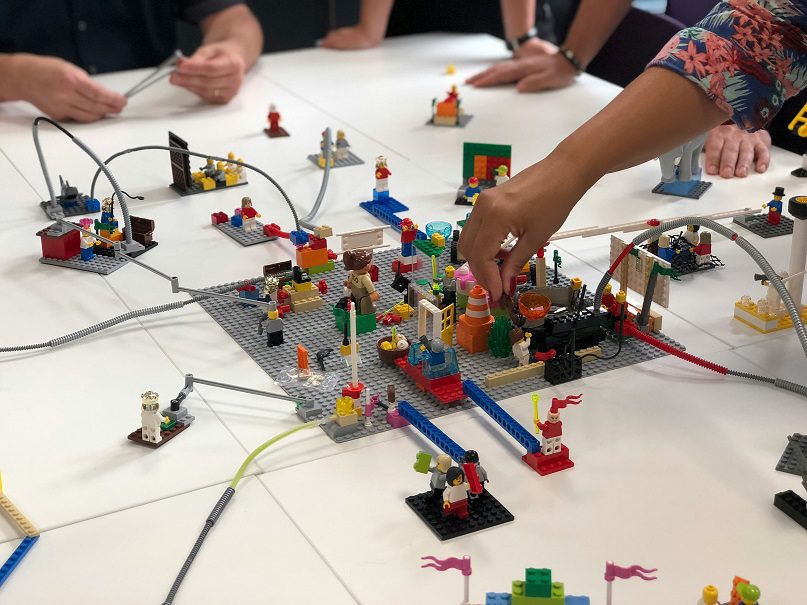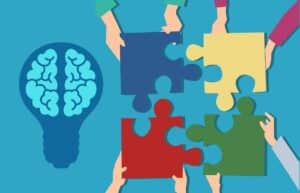Continuous learning is crucial in today’s fast-paced, information driven world.
One of the most powerful ways to achieve that? Tactile learning – the “hands-on” approach that has revolutionized how we retain concepts and build genuine skills.
From childhood activities like planting a garden with a family member to constructing intricate lego structures, these tactile experiences create lasting impressions. As we grow, the need for such vivid, physical engagement in learning persists. This article explores innovative multi-sensory techniques that enhance lifelong learning and showcases how emerging technologies like VR and AR are making education not just interactive but truly immersive.
Understanding Tactile Learning
Ever wonder why lessons from a hands-on science lab linger longer in your memory than those read from a textbook? This is tactile learning in action, where physical engagement is not just beneficial but essential.
The Power of Tactile Learning:
Interactive Engagement: When you dive into learning with your hands, your brain engages differently. Handling materials and manipulating objects brings lessons to life in a way that reading simply can’t match.
Memory Mastery: Writing notes by hand or building models solidifies learning through muscle memory. This type of physical memory processing helps to cement knowledge more deeply than auditory or visual input alone.
Real-World Skills: Tactile learning isn’t just about remembering facts; it’s about applying them. Activities like molding sculptures or assembling circuits hone practical skills that classroom lectures often overlook.
Imagine mastering math by constructing geometric shapes or studying history by crafting timelines with tangible materials. Tactile learning transforms abstract concepts into tactile experiences, ensuring knowledge is not only absorbed but also retained. It’s learning that sticks, quite literally, at your fingertips. Ready to get hands-on?
Practical Tactile Learning Strategies for Adults
As adults, learning doesn’t stop. In fact, it becomes integral to personal growth and professional development. Tactile learning strategies can be especially beneficial, not just for kinetic learners but for anyone looking to enhance memory retention and understanding in daily life.
Strategy 1: Embrace Hands-on Activities
Hands-on activities are a powerful way to grasp complex concepts and retain information longer. For adults, the application of tactile learning can be found in:
- DIY Projects: Engaging in do-it-yourself home improvement projects can help understand geometrical measurements and planning skills. Assembling furniture or creating home decor can turn abstract concepts into tangible results.
- Cooking: Preparing meals requires precise measurement and timing, akin to practical chemistry. Following recipes can enhance one’s ability to follow sequential steps and improve problem-solving skills when adjustments are needed.
Strategy 2: The Value of Writing by Hand
Despite the digital age, the physical act of writing has significant cognitive benefits:
- Note-Taking: During meetings or webinars, writing notes by hand rather than typing can help in processing and retaining the information being discussed. Handwriting aids in encoding the information more deeply into memory.
- Planning Sessions: Using a pen and paper for planning projects or to-dos can make the process more deliberate and memorable, reducing the chances of forgetting important tasks.
Strategy 3: Incorporate Movement into Learning
Movement can be an excellent catalyst for learning. It not only helps in physical health but also enhances mental clarity and memory retention:
- Walking Meetings: Instead of sitting in a conference room, try walking meetings. This method not only encourages a healthy lifestyle but also boosts creativity and focus.
- Light Exercises During Learning: Engaging in light physical activity such as stretching or yoga during learning breaks can help maintain energy levels and concentration. For example, consider brief exercise routines during long study sessions or strategic planning.
- Educational Podcasts During Exercise: Listening to podcasts related to professional development or personal interests during a workout can make the learning experience more dynamic and enjoyable.
Implementing these tactile learning strategies can make learning more engaging and effective for adults. Whether you’re looking to improve your professional skills or just enrich your personal knowledge base, these methods provide practical, memorable ways to continue your education every day.

Expanding Tactile Learning Opportunities
Activity 1: Technology Integration – Tactile Educational Apps and Simulations
In this activity, you’ll dive into the world of educational apps and simulations that incorporate tactile interactions. These apps use the sense of touch to make learning more engaging and interactive. Here’s what to explore:
- Osmo: Combining physical pieces with digital environments, Osmo promotes learning through interactive play. Perfect for subjects like math and spelling, it helps kids visualize concepts in a fun way.
- PhET Interactive Simulations: Developed by the University of Colorado Boulder, these simulations offer touch-based interactions that make learning scientific concepts intuitive and hands-on.
- Reactable: This app allows users to create and manipulate music through tangible blocks, making the process of learning music both tactile and visual.
- Merge Cube: AR cube for interactive 3D learning experiences.
- Quiver: Color and watch characters leap off the page in augmented reality.
- LEGO Education: Build & code robots for playful STEM adventures.
These are some applications that not only enhance learning but also make it a more enjoyable and effective experience.
Activity 2: Social-Emotional Learning – Role-Playing and Model-Building
Social-emotional learning (SEL) is crucial in developing empathy, resilience, and emotional intelligence. This activity uses role-playing and model-building to enhance these skills:
- Role-Playing: Through simulated scenarios, students can act out various social situations, such as resolving conflicts or making decisions. This method helps them understand different perspectives and build empathy.
A study in the Journal of Evidence-Based Social Work in 2018 found that role-playing activities increased empathy and perspective-taking abilities in social work students. - Model-Building: Creating physical models that represent emotions or abstract concepts can aid in visualizing and understanding feelings and reactions. For instance, building a “bridge” out of blocks to represent problem-solving in friendships can make abstract concepts more concrete.
A real-life example can be seen in programs like LEGO® Education, which uses bricks to build models representing various emotional states. This facilitates discussions about feelings and behaviors among students.
How to implement role-playing effectively in tactile learning:
- Define Objectives: Target skills like customer service improvement.
- Develop Scenarios: Create a scenario where an employee handles a customer returning a faulty product.
- Assign Roles: Participants act as both the employee and the customer, equipped with specific complaints and policies to follow.
- Set the Scene: Arrange a counter, return items, and a store layout to simulate a real retail environment.
- Guide the Role-Play: Monitor interactions, providing feedback on communication techniques and problem-solving.
- Debrief: Conclude with a group discussion on effective strategies and personal reflections to solidify learning.
How to use model-building in tactile learning:
- Concept Selection: Choose a complex system, like the human respiratory system.
- Plan the Model: Design a diagram and list materials such as tubes and balloons for lungs.
- Gather Materials: Collect all necessary components.
- Build the Model: Guide students in assembling the model, focusing on the structure and function of each part.
- Discussion: Utilize the model for an interactive lesson on how breathing works.
- Assessment: Test understanding by having students explain or demonstrate the breathing process using the model.
Both techniques not only teach important life skills but also encourage creativity and critical thinking. Engaging in these activities fosters a deeper understanding of oneself and others, crucial for character development and emotional intelligence.
Activity 3: Differentiation for Age Groups
Tailoring tactile activities for varying educational levels enhances learning across all ages:
- Young Children: Simple tactile games like finger painting or block building improve fine motor skills and basic concept learning.
- Teenagers: More complex projects like constructing models or assembling DIY electronics kits enhance problem-solving and critical thinking.
- Adults: Advanced simulations and virtual reality experiences can provide real-life skills and professional training. For example, using a VR simulation to practice surgical techniques or flight training allows adults to acquire specialized skills in a controlled, realistic environment.
Customizing tactile experiences based on the learner’s age not only makes the learning process more effective but also more engaging, ensuring that each group gains the most benefit from the activities.
Addressing Challenges in Tactile Learning
Challenge 1: Addressing Sensory Sensitivities
When adapting tactile learning for students with sensory sensitivities, it’s important to make thoughtful changes to ensure all students are comfortable and can fully engage:
- Material Choices: Offer a range of textures so students can select options that don’t overwhelm them.
- Environment Tweaks: Modify the learning space to reduce sensory triggers, such as loud sounds or bright lights.
- Personalized Strategies: Tailor activities to meet the individual sensory needs of each student.
These steps help create a more inclusive learning environment that supports the diverse sensory experiences of students.
Challenge 2: Assessment and Individualization
To effectively customize tactile learning activities, it’s crucial to understand each student’s unique learning style. Here are the steps and timing for achieving this:
- Learning Style Assessments: Early at the beginning of a course, use tools like questionnaires, observations, and learning style inventories. These tools help determine whether students learn best through auditory, visual, or kinesthetic methods.
- Activity Customization: Based on the assessment results, tailor tactile activities to match the identified learning styles. For example, kinesthetic learners might benefit most from hands-on activities, while visual learners could engage more with color-coded or visually structured materials.
- Continuous Feedback: Throughout the course, regularly collect feedback through various methods such as surveys, direct discussions, and performance reviews. This allows for ongoing adjustments to the tactile activities to better suit student needs and enhance learning effectiveness.
Implementing these steps at strategic times ensures that tactile learning is personalized from the start and remains adaptive to student feedback and progress.
Challenge 3: Long-Term Learning Strategies
Developing effective long-term learning strategies for tactile learners involves several key practices:
- Repetition and Practice: Regular hands-on activities help reinforce learning and improve retention. Encourage tactile learners to repeatedly engage with materials.
- Integration of Techniques: Combine tactile learning with visual and auditory methods to create a comprehensive learning experience that caters to all senses.
- Active Recall: Implement activities that require students to retrieve information actively. This could include building models from memory or teaching back a concept to peers.
- Study Routines: Help tactile learners establish consistent, structured study habits that involve physical interaction with learning materials.
Innovative Tactile Learning Approaches for the Visually Impaired.
Blind individuals are already used to tactile learning through methods like braille. To support their wider educational goals, we need to expand and vary the types of tactile experiences they get. This allows learning that goes beyond just reading and writing through touch.
. Here are several strategies:
- Multi-textural Materials: Utilize a variety of materials with different textures to teach concepts beyond text. For example, use raised maps for geography, textured cells for biology, or different fabrics to teach art or design concepts.
- 3D Models and Manipulatives: Provide three-dimensional models for subjects like science and mathematics. For instance, use tactile models of molecules, geometric shapes, or anatomical parts to provide a concrete understanding of abstract concepts.
- Tactile Graphics: Employ tactile graphics which are diagrams, charts, or illustrations adapted for touch. These can help in subjects such as math and science where visual information is crucial.
- Technology Integration: Incorporate technology designed for the blind, such as tactile tablets that use vibrations or other mechanisms to convey images or text, and audiobooks or software that can translate text into Braille.
- Interactive Learning: Encourage active learning through role-playing or simulations that require physical activity or the use of tactile props, enhancing understanding and retention of information.
By leveraging these strategies, educators can create a rich, multi-sensory learning environment that builds on the tactile skills blind students already possess through their experience with Braille, thus deepening their educational experience and understanding.

The Future of Tactile Learning
While the fundamental advantages of tactile learning have remained constant, the landscape is shifting dramatically due to technological advancements. Tools like virtual reality (VR), augmented reality (AR), haptic feedback, and 3D printing are poised to revolutionize our educational experiences through immersive, multisensory learning environments.
Consider the practical applications of these technologies today:
- Virtual Reality: Students can wear VR headsets to explore a simulated Mars landscape, not just seeing it but feeling the terrain underfoot through synchronized treadmill platforms.
- Augmented Reality: Using AR glasses, learners can overlay molecular structures in their physical space, manipulating them to understand complex chemical bonds.
- Haptic Feedback: Integrating haptic suits in geological studies, students can experience the tactile sensation of different rock textures or temperature changes that characterize specific earth layers.
- 3D Printing: In biology classes, students can print and assemble parts of human anatomy, allowing for hands-on study of organs in a classroom setting.
As computing power merges more seamlessly with everyday objects, we envision transforming any environment into an interactive learning space. Smart surfaces could soon detect touch and gestures, bringing digital information into the physical world through simple interactions. This blend of the physical and digital realms is set to create a new era of education that engages all senses, making learning a more tangible and engaging experience.
Final Thoughts
Learning isn’t just about reading. Engaging our sense of touch strengthens memory and understanding. From building models to writing by hand, tactile activities create a richer learning experience.
With the integration of VR, AR, and 3D printing, we’re pushing the boundaries further, making education not only immersive but also deeply interactive. These technologies are crucial for ensuring that lessons are not just memorized but genuinely understood and applied.
Let’s unlock the power of tactile learning. This isn’t just learning; it’s an interactive journey that transforms how we absorb information.
Resources
Active Learning: 101 Strategies to Teach Any Subject by Mel Silberman
Good Sensory Learning: a variety of tips for tactile learners including adults



